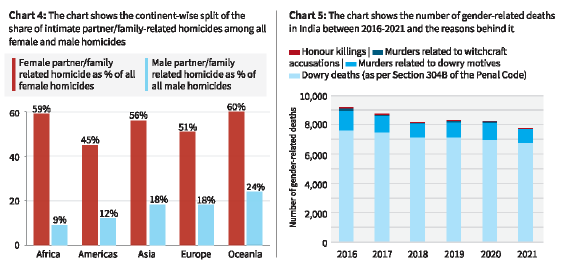Social Justice
Gender-Related Killings of Women and Girls
- 27 Nov 2023
- 4 min read
For Prelims: Gender-related killings of Women and Girls, United Nations Office on Drugs and Crime (UNODC), Femicide/Feminicide, United Nations International Drug Control Program (UNDCP).
For Mains: Gender-related killings of Women and Girls, Welfare schemes for vulnerable sections of the population by the Centre and States and the performance of these schemes.
Why in News?
Recently, the United Nations Office on Drugs and Crime (UNODC) and UN Women released a study titled-Gender-related killings of women and girls (femicide/feminicide), revealing an increase in gender-related killings of women and girls in 2022.
What is Femicide/Feminicide?
- Femicide or feminicide refers to the deliberate killing of women or girls purely because they are female. It’s a gender-based crime rooted in deeply ingrained societal attitudes and discrimination against women.
- Femicide differs from homicide in that it specifically targets individuals due to their gender, often involving situations where women are killed by their partners, family members, or individuals due to reasons like misogyny, gender-based violence, or cultural beliefs that devalue women.
What are the Key Highlights of the Study?
- Femicide Trends:
- Globally, nearly 89,000 women and girls were killed intentionally in 2022, the highest yearly number recorded in the past two decades.
- While the overall number of homicides globally has begun to fall in 2022 after a spike in 2021, the number of female homicides are not decreasing.
- Perpetrator-Victim Disparity:
- Women are more likely to be victims of intimate partner or family-related homicides compared to men.
- While most homicides worldwide are committed against men and boys (80% in 2022), women and girls are disproportionately affected by homicidal violence in the home: they represent approximately 53% of all victims of killings in the home and 66% of all victims of intimate partner killings.
- Continental Trends:
- Africa reported the highest number of intimate partner/family-related homicides of women in 2022, surpassing Asia for the first time in 13 years.
- The Americas, while reporting fewer cases, exhibited relatively higher rates of such femicides per 100,000 female population.
- Regional Variations and Recent Changes:
- With an estimated 20,000 victims in 2022, Africa has – for the first time since 2013 surpassed Asia as the region with the highest number of victims in absolute terms.
- In 2022, Africa was also the region with the highest number of victims relative to the size of its female population (2.8 victims per 100,000 women).
- Between 2010 and 2022, Europe witnessed an average reduction in the number of female intimate partner/family-related homicides (by 21%), albeit with differences across sub-regions and with some setbacks in Western and Southern Europe, especially since the onset of the Covid-19 pandemic in 2020.
- India-Specific Insights:
- India experienced a slight decline in gender-based killings over the past decade, although issues like dowry-related deaths, honour killings, and witchcraft accusations persist.
- Dowry-related reasons consistently topped the list as the leading cause of gender-related deaths in India, with honour killings and witchcraft-related murders forming a smaller percentage.
What is the United Nations Office on Drugs and Crime (UNODC)?
- It was established in 1997 and was named as a UNODC in 2002.
- It acts as the Office for Drug Control and Crime Prevention by combining the United Nations International Drug Control Program (UNDCP) and the Crime Prevention and Criminal Justice Division of the United Nations Office at Vienna.








